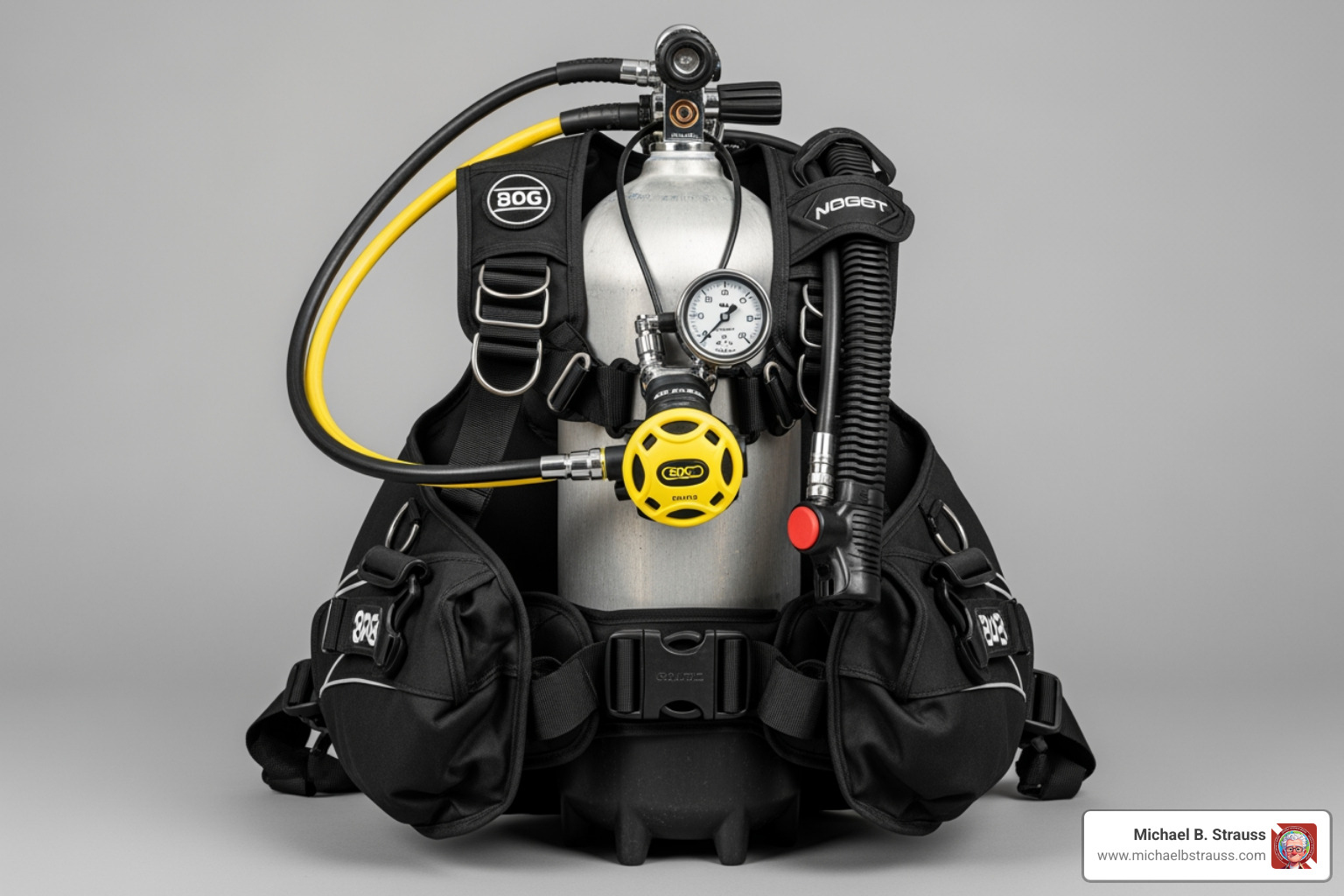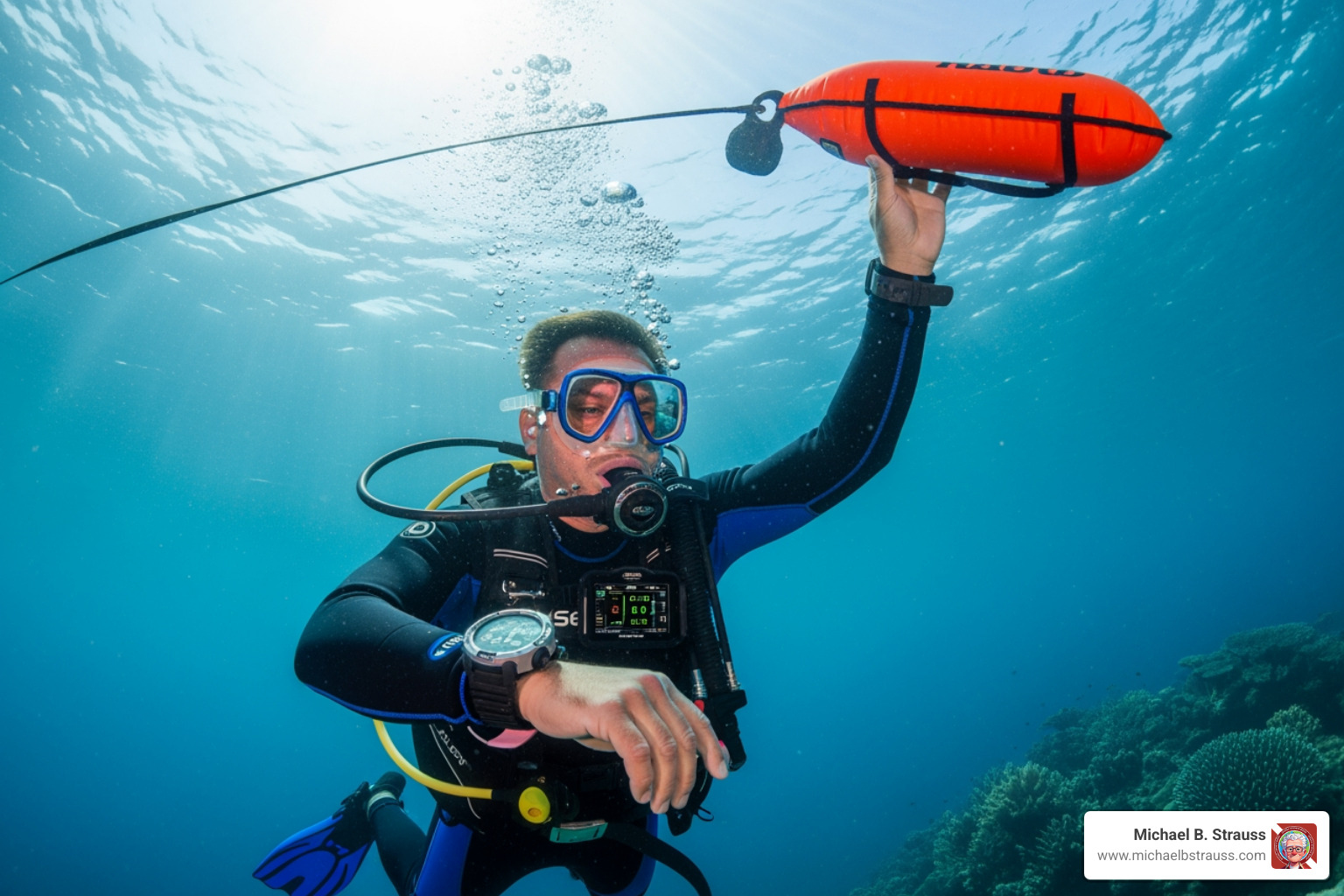Why the Right Scuba Diving Equipment Makes All the Difference
A scuba diving equipment guide is your first step toward understanding the gear needed for safe underwater exploration. Whether you're a new diver or an experienced one, knowing your equipment is crucial for both safety and enjoyment.
Essential Scuba Diving Equipment:
- Personal Gear - Mask, fins, snorkel (your window and propulsion underwater)
- SCUBA System - Tank, regulator, BCD, weights (your life support system)
- Instruments - Dive computer, pressure gauge, compass (your navigation and monitoring tools)
- Safety Devices - Surface marker buoy, dive light, knife or line cutter (your emergency tools)
- Exposure Protection - Wetsuit or drysuit (your thermal protection)
To a newcomer, scuba gear can seem like a complex collection of hoses, rubber, and metal. Is it all necessary? The short answer is yes. Each piece serves a specific purpose in adapting you to the underwater environment. A mask allows you to see clearly, a regulator lets you breathe, and a wetsuit helps your body retain heat.
Understanding your equipment is more than just knowing what to buy or rent. It's about knowing how each piece functions, how to maintain it, and how to use it in unexpected situations. This knowledge is fundamental to your safety and confidence underwater.

Scuba diving equipment guide vocabulary:
Your Complete Scuba Diving Equipment Guide
Personal Dive Gear: Your Window and Engine
Let's start with the personal gear that connects you to the underwater world. These items are often the first pieces divers buy because a good fit is essential for comfort and performance.

Your Dive Mask: The Window to Wonder
Your diving mask creates an air pocket that allows your eyes to focus underwater. It also covers your nose, letting you equalize pressure as you descend to prevent the uncomfortable 'squeeze' feeling. To find the right mask, hold it to your face without the strap and inhale gently through your nose. If it creates a seal and stays put, it's a good fit. Most modern masks use a soft silicone skirt for a comfortable, durable seal. A low-volume mask is often easier for beginners to clear of water.
Your Fins: From Clumsy to Graceful
Fins are your engine, converting leg power into smooth propulsion. They help you conserve energy and steer with precision. There are two main styles: full-foot fins, which slip on like shoes and are great for warm water, and open-heel fins, which are worn with dive booties for versatility and protection. Your choice depends on your diving environment. Fins for precise movements, like those needed for underwater photography, are often smaller and heavier, while longer, lightweight fins provide powerful propulsion in currents. A snug but comfortable fit is crucial to transfer power efficiently.
Your Snorkel: The Underrated Essential
A snorkel allows you to breathe at the surface without lifting your head, conserving tank air before or after a dive. This is useful when swimming out from shore or waiting for a boat. Look for one with a comfortable mouthpiece that won't fatigue your jaw. It's a simple but valuable piece of safety and convenience equipment.
The Core Life Support (SCUBA) System
SCUBA stands for Self-Contained Underwater Breathing Apparatus—the system that keeps you alive and comfortable beneath the waves. For an overview of how the complete setup works, see the scuba set.

The Scuba Tank: Your Portable Air Supply
The scuba tank is a cylinder containing high-pressure breathing gas, usually air or enriched air nitrox. Tanks are typically made from steel or aluminum. While most divers rent tanks at their destination, understanding their function is crucial as they provide every breath you take underwater.
The Buoyancy Control Device: Your Underwater Elevator
Your Buoyancy Control Device (BCD) is a wearable vest that holds your tank and allows you to control your position in the water. By adding or releasing air, you can achieve neutral buoyancy, letting you hover effortlessly at any depth. This protects marine life, improves air consumption, and makes diving feel magical. A good fit is essential for comfort and control.
The Regulator: Your Lifeline
Your regulator is your life support system, converting the high-pressure air from your tank into breathable air on demand. A complete system includes a first stage that attaches to the tank, a primary second stage that you breathe from, and an alternate second stage (or octopus) for sharing air with a buddy in an emergency. A quality regulator delivers air with minimal effort.
Weights: Overcoming Your Natural Float
Because our bodies and exposure suits are buoyant, we need weights to descend and stay underwater. Weights can be worn on a belt or in integrated pockets within the BCD. Integrated systems are popular as they distribute weight more comfortably and can be released quickly in an emergency. The correct amount of weight is critical for controlling your ascent and descent.
Essential Instruments and Safety Devices
These tools help you monitor your dive and signal for help, turning a risky adventure into a manageable activity.

Your Dive Computer: The Underwater Dashboard
Your dive computer is an essential safety device that tracks your depth, dive time, and no-decompression limits to help you avoid decompression sickness. A good beginner computer has a clear, backlit display and audible alarms. The principles behind these calculations are explored in Diving Science and Decompression Science.
The Submersible Pressure Gauge: Your Air Monitor
A submersible pressure gauge (SPG) shows how much air is left in your tank. It is your primary tool for air management, helping you decide when to end your dive and begin your ascent. Some dive computers have this function integrated.
Your Compass: Finding Your Way
A compass is crucial for underwater navigation, especially in low visibility or at unfamiliar sites. It helps you maintain your course and find your way back to your entry or exit point.
Safety Signaling Devices: Being Seen and Heard
- A Surface Marker Buoy (SMB) is an inflatable tube that marks your location for boats on the surface. It is essential for safety stops and in areas with boat traffic.
- A whistle or other audible device helps attract attention at the surface if you get separated from your group.
- A dive light is necessary for night dives and exploring dark areas, but also serves as a signaling device. Always carry a primary and a backup.
- A dive knife or line cutter is a safety tool for freeing yourself or a buddy from mess in fishing lines or nets.
Exposure Protection: Staying Warm and Safe
Exposure protection keeps you warm and protects your skin from the environment.
Wetsuits: Your Second Skin
A wetsuit works by trapping a thin layer of water against your skin, which your body heats to provide insulation. They come in various thicknesses (1mm to 7mm) depending on the water temperature.
- Tropical waters (28°C/82°F+): A 1-3mm suit provides protection from sun and scrapes.
- Temperate waters (20-28°C/68-82°F): A 3mm or 5mm full suit is common.
- Colder waters (below 20°C/68°F): A 7mm suit, often with a hood and gloves, is needed.
A snug fit is key; if it's too loose, cold water will flush through and defeat the purpose.
Drysuits: The Cold Water Solution
A dry suit keeps you completely dry with waterproof material and seals at the neck and wrists. You wear insulating undergarments for warmth, making it ideal for very cold water. Diving with a dry suit requires special training, as buoyancy control is different from diving in a wetsuit.
To Buy or To Rent? A Beginner's Dilemma
Deciding whether to buy or rent gear depends on your budget and how often you plan to dive.
Renting is cost-effective for infrequent divers. It lets you try different gear and avoids maintenance and travel hassles. However, rental gear may not fit perfectly, and costs can add up for frequent divers.
Buying ensures a perfect fit, comfort, and confidence from using familiar equipment. It's more cost-effective in the long run for active divers, but requires a significant upfront investment and responsibility for maintenance.
A Practical Approach: Most beginners start by buying personal items like a mask, fins, and snorkel for comfort and fit. You can rent larger items like the BCD and regulator until you have more experience and know your preferences. If you dive more than 10-15 times a year, investing in a full set of gear is often worthwhile.
Scuba Gear Care and Maintenance
Proper care is fundamental to the safety and longevity of your equipment.

- After Every Dive: Thoroughly rinse all equipment with fresh water to remove salt, chlorine, and sand.
- Drying: Air-dry everything completely in a shaded, well-ventilated area. Direct sunlight degrades materials like neoprene and rubber.
- Storage: Store gear properly to maintain its integrity. Keep regulators loosely coiled, BCDs partially inflated, and wetsuits on wide hangers.
- Professional Servicing: Your life-support equipment (regulator, BCD) requires annual professional servicing by an authorized technician. This is a non-negotiable part of responsible diving.
- Pre-Dive Checks: Before every dive, inspect your gear for wear and tear. Check hoses, O-rings, and buckles. This simple routine can prevent problems underwater.
Conclusion: Your Next Steps in Diving Safety
This scuba diving equipment guide has covered the essential gear that allows us to safely explore a world not designed for humans. From the mask that provides clear vision to the regulator that delivers each breath, understanding your equipment is fundamental to safe and enjoyable diving.
Knowing how your gear works, why it's important, and how to care for it is a cornerstone of diver confidence. The decision to rent or buy is personal; many start by purchasing comfort items like a mask and fins, then invest in life-support gear as they gain experience. Regardless of what you use, ensure it fits well, functions reliably, and is properly maintained.
However, the most critical piece of equipment you will ever have is your training and knowledge. No gear can replace proper education and a commitment to continuous learning. Becoming a safer, more confident diver is an ongoing journey.
Dr. Michael B. Strauss has dedicated his career to diving safety, offering invaluable guidance for divers of all levels. To deepen your understanding of topics like decompression science and other safety protocols, we encourage you to explore the wealth of knowledge available at michaelbstrauss.com/resources. From diving science to advanced scuba diving tips, these resources will support your growth as a diver. For a comprehensive guide, get your copy of his book, Diving Science Revisited.
With the right gear, training, and a commitment to safety, the underwater world is yours to explore. Happy diving!
DISCLAIMER: Articles are for "EDUCATIONAL PURPOSES ONLY", not to be considered advice or recommendations.






